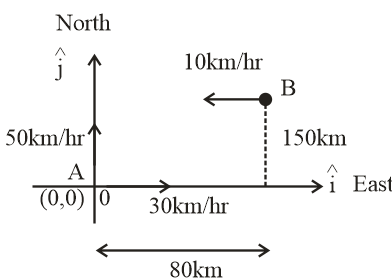Question
Question: Ship A is sailing towards the north east with velocity \(\vec v = 30\hat i + 50\hat jkm/hr\) where \...
Ship A is sailing towards the north east with velocity v=30i^+50j^km/hr where i^ points east j^ and north. Ship B is at a distance of 80 km east and 150 km north of ship A and is sailing towards west at 10 km/hr. A will be at minimum distance from B in
(A) 4.2 hours
(B) 2.2 hours
(C) 3.2 hours
(D) 2.6 hours
Solution
We know that the relation between time, velocity and displacement is given as
Time =velocitydisplacement
And the above expression is also applicable for relative motion like relative velocity, relative displacement etc. But time does not depend on frame of reference.
Complete step by step answer:

Given that initial positions of ship A & B is
rA=0i^+0j^ …..(1)
rB=(80i^+150j^)km ….(2)
So, the relative position of B with respect to A
rBA=(80i^+150j^)km …..(3)
Also, given that the velocity of ship A & B is
vA=(30i^+50j^)km/hr
vB=−10i^km/hr
So, relative velocity of B with respect to A is
vBA=−10i^−(30i^+50j^)
=−10i^−30i^−50j^
vBA=−40i^−60j^ …..(4)
And magnitude of vAB is given as
∣vBA∣=(40)2+(50)2
1600+2500
∣vBA∣=4100 …..(5)
We know that
Time t =velocity(v)displacement(r)
In relative motion
t=vBArBA
On multiplying vBA⇒t=vBA⋅vBArBA⋅vBA
t=∣vBA∣2rBA⋅vBA
So, from equation 3, 4 & 5
t=(4100)2(80i^+150j^)⋅(−40i^−50j^)
t=4100[−(80×40)]+[−(150×50)]
t=4100−3200−7500=4100−10700
Time never be –ve, hence
t=410010700=41107=2.6 hours
t=2.6 hours
So, the correct answer is “Option D”.
Note:
Relative motion is a concept which makes numerical problems easy. We can apply the above formulae only when there is no acceleration given to particles. Time does not depend on frame of reference.
